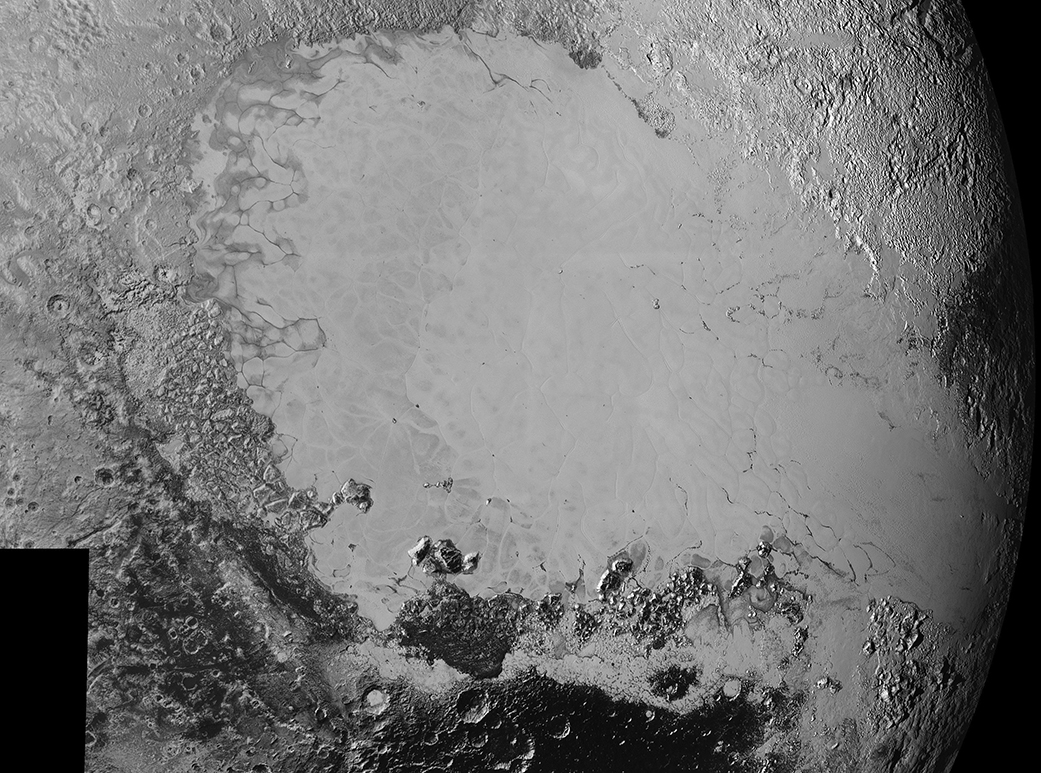
NASA's New Horizons spacecraft beamed home incredible new images of Pluto, scientists found a giant buried ice sheet on Mars and Elon Musk chatted with Stephen Colbert about the future of spaceflight. Here are Space.com's top stories of the week.
Pluto in breathtaking new detail
Supersharp new images just received from NASA's New Horizons spacecraft show a stunning variety of complicated surface features on Pluto. [Full Story: New Photos of Pluto Show a World More Complex and Beautiful Than Ever]
Huge ice sheet found on Mars
A giant slab of ice as big as California and Texas combined lurks just beneath the surface of Mars between its equator and north pole, researchers say. [Full Story: Gigantic Ice Slab Found on Mars Just Below the Planet's Surface]
Elon Musk chats with Stephen Colbert
Elon Musk appeared on "The Late Show with Stephen Colbert" Wednesday night (Sept. 9) to talk about dropping nuclear bombs on Mars, the future of rocket travel and a creepy, snakelike robot for electric-car owners. [Full Story: Stephen Colbert Says Elon Musk Is Either a Supervillain or a Superhero]
Get the Space.com Newsletter
Breaking space news, the latest updates on rocket launches, skywatching events and more!
NASA still considering lander for Europa mission
NASA's upcoming mission to Europa will primarily be a flyby affair, but it may also include a small lander that touches down on the potentially life-harboring Jupiter moon. [Full Story: NASA's Europa Mission May Land on Ocean-Harboring Moon]
NASA developing 'hedgehog' robot for comet, asteroid exploration
Researchers tested two "hedgehog" robot prototypes this summer to get an idea of the machines' potential to explore space locations inaccessible to conventional rovers. [Full Story: Hopping 'Hedgehog' Robot Could Explore Comets and Asteroids]
Is this how we'll get samples back from Mars?
A mission that uses SpaceX's Dragon capsule to help bring chunks of Mars rock back to Earth for analysis could launch as early as 2022, scientists say. [Full Story: 'Red Dragon' Mars Sample-Return Mission Could Launch by 2022]
Stunning view of alien planets being born
When an image of the extrasolar system HL Tau was unveiled last year, it sparked controversy over whether or not grooves in the disk of dust surrounding the star could be explained by the presence of newly formed giant planets. Now, a new paper suggests that the orbit of those planets could serve to stabilize rather than eject one another, as had originally been suggested. That means this image is the first time scientists have observed a forming planetary system, and a tightly packed one at that. [Full Story: First Image of Planet Birth Shows Tightly Packed Worlds]
A look inside SpaceX's astronaut taxi
SpaceX has thrown open the hatch to its Crew Dragon spacecraft, revealing a sleek black and white interior for the capsule it is building to fly astronauts to the International Space Station and other destinations. [Full Story: Step Inside Crew Dragon: SpaceX Reveals Interior of Crewed Space Capsule]
Surprise! Mercury spinning faster than thought
New research shows that Mercury completes one rotation on its axis roughly 9 seconds more quickly than scientists previously charted — and that information will help scientists understand more about the planet's molten core. [Full Story: Mercury's Speedy Spin Hints at Planet's Insides]
Follow Mike Wall on Twitter @michaeldwall and Google+. Follow us @Spacedotcom, Facebook or Google+. Originally published on Space.com.
Join our Space Forums to keep talking space on the latest missions, night sky and more! And if you have a news tip, correction or comment, let us know at: community@space.com.

Michael Wall is a Senior Space Writer with Space.com and joined the team in 2010. He primarily covers exoplanets, spaceflight and military space, but has been known to dabble in the space art beat. His book about the search for alien life, "Out There," was published on Nov. 13, 2018. Before becoming a science writer, Michael worked as a herpetologist and wildlife biologist. He has a Ph.D. in evolutionary biology from the University of Sydney, Australia, a bachelor's degree from the University of Arizona, and a graduate certificate in science writing from the University of California, Santa Cruz. To find out what his latest project is, you can follow Michael on Twitter.